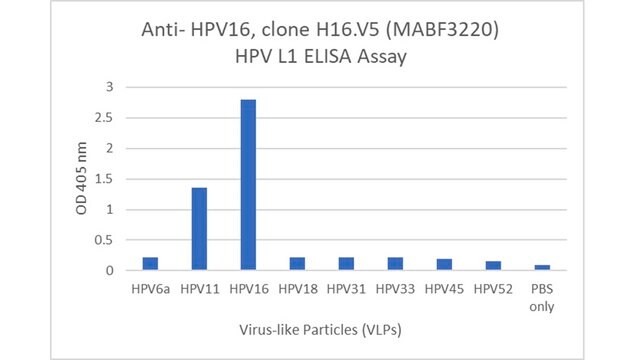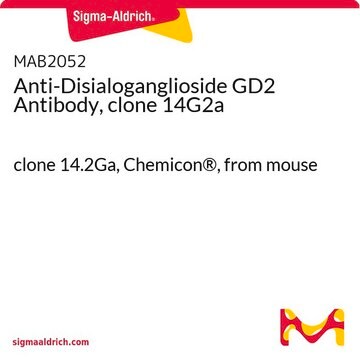MAB885
Anti-Papillomavirus Antibody, 16L1, late protein, clone Cam Vir-1
clone Cam Vir-1, Chemicon®, from mouse
Sinónimos:
HPV
About This Item
Productos recomendados
origen biológico
mouse
Nivel de calidad
forma del anticuerpo
purified antibody
tipo de anticuerpo
primary antibodies
clon
Cam Vir-1, monoclonal
reactividad de especies
human
fabricante / nombre comercial
Chemicon®
técnicas
immunohistochemistry: suitable (paraffin)
immunoprecipitation (IP): suitable
western blot: suitable
isotipo
IgG2a
Condiciones de envío
wet ice
Especificidad
Inmunógeno
Aplicación
Immunohistochemistry.
Shows reactivity on fixed tissue. Dilute with buffer pH 7.5 -8.0 to desired working volumes. For extensive dilution, protein containing or other stabilizing medium should be used. Final working dilutions must be determined by end user.
Infectious Diseases
Infectious Diseases - Viral
Forma física
Almacenamiento y estabilidad
Otras notas
Información legal
Cláusula de descargo de responsabilidad
¿No encuentra el producto adecuado?
Pruebe nuestro Herramienta de selección de productos.
Código de clase de almacenamiento
10 - Combustible liquids
Clase de riesgo para el agua (WGK)
WGK 2
Punto de inflamabilidad (°F)
Not applicable
Punto de inflamabilidad (°C)
Not applicable
Certificados de análisis (COA)
Busque Certificados de análisis (COA) introduciendo el número de lote del producto. Los números de lote se encuentran en la etiqueta del producto después de las palabras «Lot» o «Batch»
¿Ya tiene este producto?
Encuentre la documentación para los productos que ha comprado recientemente en la Biblioteca de documentos.
Nuestro equipo de científicos tiene experiencia en todas las áreas de investigación: Ciencias de la vida, Ciencia de los materiales, Síntesis química, Cromatografía, Analítica y muchas otras.
Póngase en contacto con el Servicio técnico






